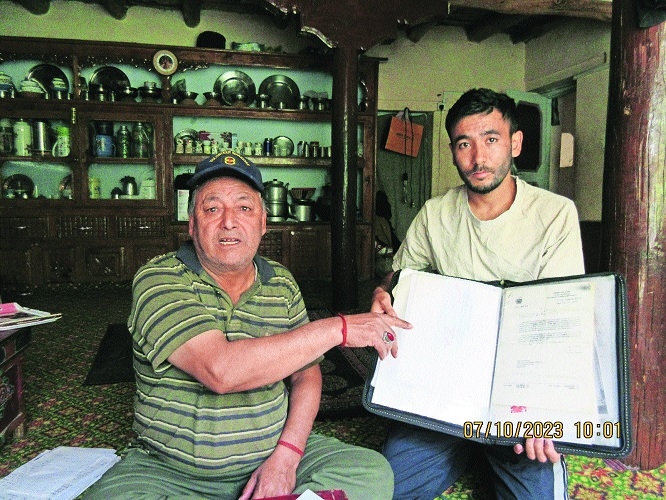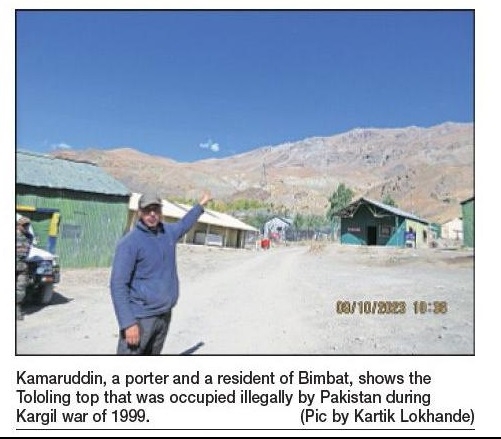No footprints on snow
| Date :07-Nov-2023 |

Tashi Namgyal with his son shows the letters of commendation he has received for informing the Indian Army about the Pakistani intrusion in Kargil Sector in 1999. (Pic by Kartik Lokhande)
By Kartik Lokhande :
Dateline Kargil-5
SPOTTING
enemy in
1999 WAR
Tashi Namgyal was searching for his lost yak,
looking through binoculars he saw movement of six unidentified
persons on Banju top. He was
startled. For, there was snow around but no footprints of people going up the mountain.
“I realised that these people had not gone up from our side.
I reported it to the Indian Army.”
May 2, 1999 was an usual day in the life of Tashi Namgyal, around 35-years-old shepherd from village Garkhun (also spelt as Garkone) in the Aryan Valley near the Batalik ranges in Ladakh. As his yaks did not return even after being
long gone, he started searching for them.
“I had bought one of the yaks just 10 days ago. How could I let it be lost? So, I started looking for it through binoculars,” recalls Tashi Namgyal, who is now around 60 years old, sitting on the upper floor of his house in Garkhun. While taking a look through binoculars at the higher reaches of the mountains around, instead of yaks he saw movement of six unidentified persons on Banju top. He was startled. For, there was snow around but no footprints of people going up the mountain. “Absence of footprints made me realise that these people had not gone up from our side. I suspected something bad happening. So, I immediately rushed to the 3 Punjab unit of the Indian Army,” he says.
This, precisely, was the first time that the Pakistani intruders were spotted in 1999. After Tashi Namgyal’s report, some time lapsed. But, then, all hell broke loose. Subsequent realisation that Pakistan had resorted to another misadventure casting an evil eye on National Highway connecting Srinagar and Leh, resulted in the Indian Army moving troops.

The three-month Indo-Pak fight in the high-altitude areas, today known as Kargil war, culminated with India flushing out or eliminating the intruders including Pakistani regulars and troops of the Northern Light Infantry, from Indian territories in Drass, Kargil, Batalik and such areas.
After reporting what he saw to 3 Punjab, things moved fast. On May 3, as he recalls, he was called to Batalik where senior officers spoke to him. Soon, he was accompanied by some men of the Indian Army to show them the location where he had seen unidentified persons. Well acquainted with the terrain, Tashi Namgyal advised to take the Yaldor-Tharu route to counter the intruders. The next day, at Yaldor, the Army got confirmation of presence of around 40 intruders. This was good enough to send the alarm bells ringing. The troops were mobilised. Still, there was no proper assessment of the training levels of the intruders. As a result, two of the 25 Indian troops sustained bullet injuries in the exchange of fire between the intruders and the Army.
“We carried the injured to the nearest village Dah. During the three-month war, I was all through with the Indian Army.
The people from my village transported arms, and also made food for the Indian forces fighting at Yaldor. There was a fantastic co-ordination between the Indian Army and the villagers of the area,” he observes.
In 2024, India will celebrate the Silver Jubilee of victory over
Pakistan in Kargil war through ‘Operation Vijay’. Since 1999, now road connectivity has improved in the area. Children are getting educated, tourists are visiting various places including the Aryan Valley villages, security has been beefed up with various posts and deployments. Since Ladakh has become the Union Territory, a lot of investment has come to the region. There is massive push to infrastructure development. Villagers are getting benefits of different welfare schemes of the Central Government. “A lot has changed,” adds Tashi Namgyal.
However, the man has a lament too.
“I was promised an award, but have not got it yet,” he rues. Today also, he lives in his village. His eldest son Tashi Wangyal studied up to Std X only, and is working as a porter with the Indian Army at Dah. His second daughter Tsering Dolkar has done MA (Hindi) from Kashmir University and is working as a lecturer at Nubra. Tsering Kunzes is the name of Tashi Namgyal’s third daughter. She has done MA (Geography-Honours) at Solan in Himachal Pradesh with aid under ‘Operation Sadbhavana’ of the Indian Army. Tashi’s youngest son Stanzin Dorje has done M.Com. from Pune in Maharashtra and is preparing for civil services examination as he wants to join the Government service.
In recognition of the valuable information he shared in 1999, Tashi Namgyal was given a ‘Merit Card’ in 2001, and a Certificate of Commendation by Maj Gen D H Summanwar VSM, the then General Officer Commanding, 8 Mountain Division, in August 2002. He got ration also from the Indian Army for a long time, and then intermittently. “But, I was promised some national recognition. I wish my service to the nation is recognised with a gallantry award.
For, I accompanied the Army in the inhospitable terrain and also rendered services,” says Tashi Namgyal. He also showed to ‘The Hitavada’ letters written by Nawang Rigzin, the then Minister for Tourism and Culture, Government of Jammu and Kashmir in 2009; and also by Tsering Samphel, the then President of Ladakh Buddhist Association. In both the letters, Rigzin and Samphel have recommended gallantry award and national award for Tashi Namgyal.
According to Tashi Namgyal, he is pained as he was ‘promised’ an ‘award’ but has been kept waiting so far. Again switching back to 1999, he says, “Our Government ordered ceasefire, which allowed the intruding Pakistanis to not only flee but also plant mines in the areas they had occupied illegally. Else, none of the intruders had been alive”. Nonetheless, he adds, his love for motherland in unflinching. If occasion arises, he stresses, he will still be out there helping the Indian Army in thwarting the enemy designs.
(To be continued)
Goat theft exposed enemy
‘THEY took away goats of locals, and got exposed’ As Kamaruddin glances at the high mountain ridges around, his eyes reflect fear from the past and promise of a bright future at the same time. He attributes fear from the past to the shelling by Pakistanis occupying the Tololing Top and areas around. And, he associates the promise of a bright future to the present-day stability, safety, and employment.
Kamaruddin is a resident of village Bimbat near Drass. His village is on one side of the highway, and on the other side is the high mountains where the ridgeline was occupied by the Pakistani forces in 1999. As he shows Tololing Top and the other high positions, Kamaruddin recalls how a Drass villager, a shepherd, had first reported the presence of the intruders to the Indian Army.
Mohd Yusuf, a resident of Drass and a shepherd, had left his goats to graze in Tololing nullah area.
After some time, his son came to him complaining that two tall men had come down from the higher reaches of Tololing and had taken away two of the goats. The description of the men left Mohd Yusuf suspicious. “Mohd Yusuf grew suspicious especially because the men stealing his goats were tall in built and did not appear to be from Drass or Bimbat. So, he reported to the Indian Army. This set the ball rolling and the rest is history in this part of Kargil Sector,” Kamaruddin tells ‘The Hitavada’.
Asked about the situation in Bimbat and Drass when the war erupted in 1999, Kamaruddin recalls, “Our life was hell”. According to him, Pakistani intruders had occupied Tololing ridgeline overlooking Bimbat and Drass. In fact, they had come down some distance from Tololing Top and had mounted a flag at a black flat area on the mountain. Bimbat was a target of LMG firing. A lot of houses got damaged and people had fled to other safer places.
“The damage to the property and threat to life made things difficult for the villagers. They supported the Indian Army in every which way possible.
Many like me worked as porters. On some occasions, many of our ponies died due to enemy fire while transporting arms and goods to Indian assault positions. But, the villagers and the Indian Army forged a solid bond of co-operation. Finally, when the war ended and Pakistani intruders were flushed out, the villagers started rebuilding their lives and properties. Today, the situation is tranquil, safe, and the life is much better,” observes Kamaruddin, while heading back to his work as a porter working for the Indian Army.